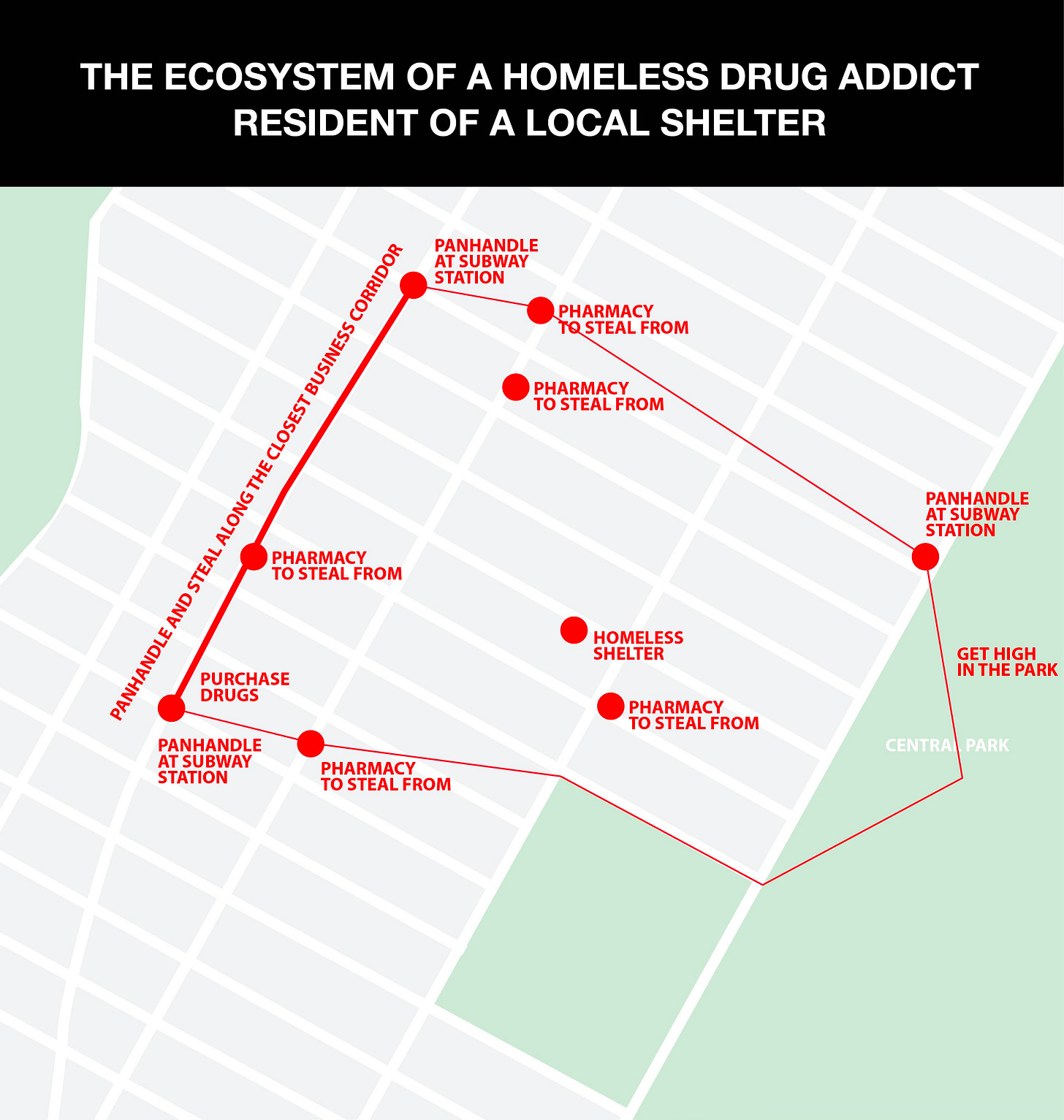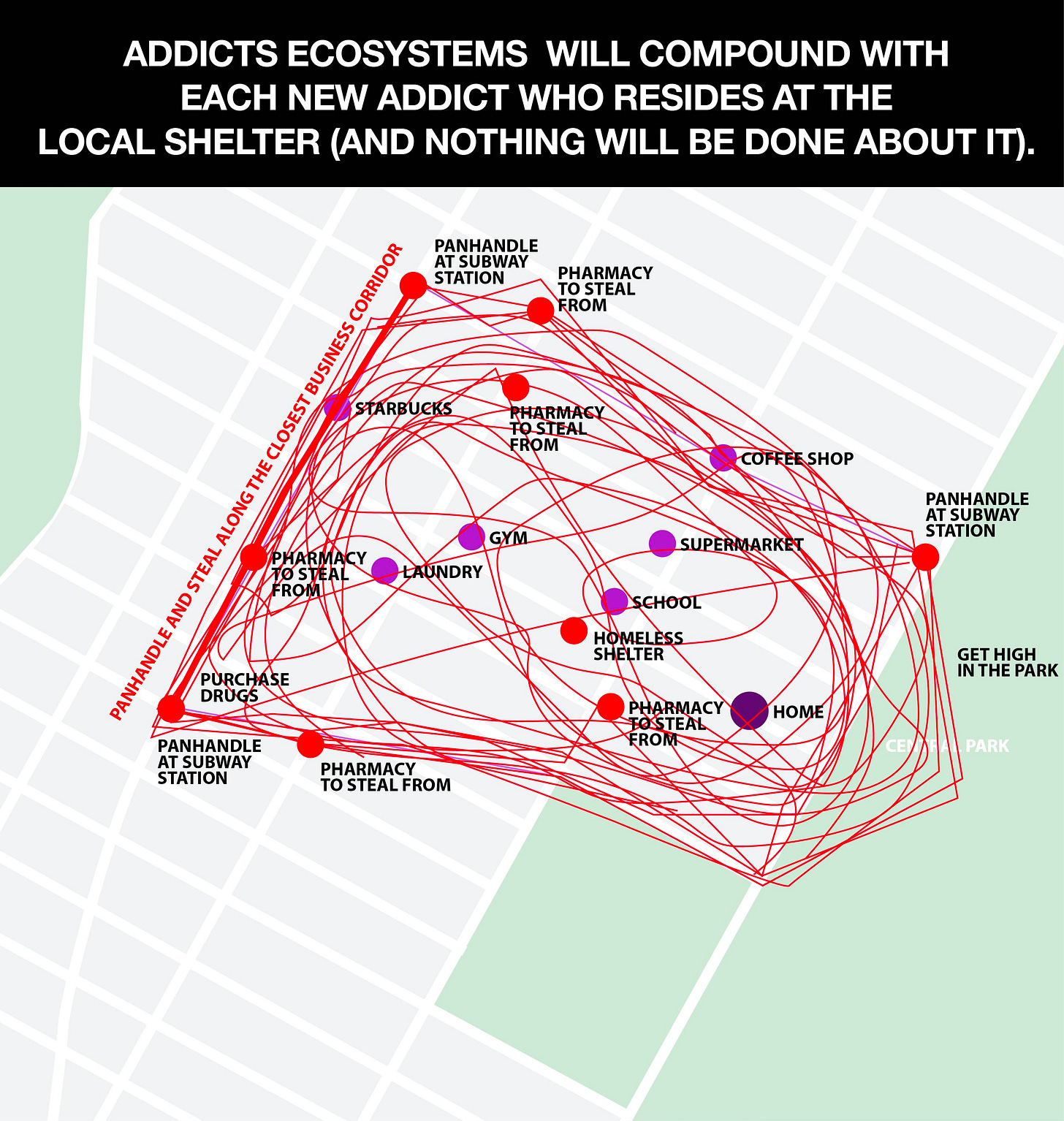The Ecosystem of Disorder
How the problems of homeless shelters become the problems of an entire neighborhood
Despite the exciting lives that many New Yorkers live, the average New Yorker spends the majority of their days living within their very own ecosystems, consisting of only a handful of necessary places to carry out their daily lives. They leave their home, take their child to school, get coffee, walk to their local subway station, go to the office, and return home. Once home, they go to the local gym, supermarket, pharmacy, laundromat, park, and a handful of local restaurants. For the sake of this exercise, let’s call this the ecosystem of an average New Yorker.
As NYC opens more homeless shelters, we must recognize the ecosystem of places the average homeless person frequents as well.
The reason we see so much street homelessness during daytime hours is that it is common practice for many of NYC’s homeless shelters to kick residents out first thing in the morning so they can clean and prepare for intake at night. As NYC reaches historic new heights of homelessness, we must ask the question:
What does the ecosystem of an average homeless person in NYC look like?
A report from NY Presbyterian Medical Center shows that 1 out of 3 homeless New Yorkers struggle with addiction. If we were to use DHS’s current data to extrapolate how many drug-addicted homeless single men are currently walking the streets of NYC, it would suggest there are about 8,000. Sounds like a lot of troubled people, right? Even still, that only accounts for names that have been signed into homeless shelter registries, meaning anyone who has not spent the night in a shelter this year remains unaccounted for.
For those in treatment programs, many have to travel daily to treatment providers in Harlem, Midtown, and the Lower East Side. As we all know, drug addicts prioritize maintaining their addiction above all else. We can pretend all we want, but the fact remains that theft and panhandling are the most common sources of income for those trapped in the cycle of homelessness and addiction.
Drug addicted homeless New Yorkers leave the shelter, go to the local major subway station to panhandle, go to the local major retail corridor to steal, purchase drugs from the local drug dealer, and then find a public place to spend their day consuming drugs and alcohol before returning to the local shelter. Drug dealers are smart enough to set up shop in areas to serve local homeless populations, often nearby the local homeless shelter or methadone clinics but not anywhere as obvious as directly across the street. Dealers often using bodegas and local fast food chains as cover for their operations.
Whenever you see an NYC Mcdonald’s location that’s filled with homeless people nodding out (like the one on 34th Street), the primary reason they are there isn’t because it’s an affordable place to eat. Even the NYTimes acknowledged that locations like the one by Macy’s are in fact drug dens where dealers prey on local homeless populations.
While many people fear being canceled and will never dare to say the quiet part out loud, the ecosystem of an average drug-addicted homeless person is unarguably detrimental to both local businesses and quality of life. We have to break free from the framework that they aren’t harming anyone and accept the fact that many homeless people’s primary income is theft and that many regularly commit violent crimes.
Last year alone, homeless people in NYC committed 564 felonies and 1,036 misdemeanor crimes.
If the average daily lives of an estimated 8,000 homeless drug-addicted men mainly consist of theft, panhandling, public intoxication, and returning to their shelter, one can see how this is directly reflected in the neighborhoods that have large single men’s shelter populations, and the increased overlap within their local resident’s daily ecosystem.
As NYC carries out its current plans to open new homeless shelters in Greenwich Village, Soho, and the Upper West Side, it’s high time we acknowledge the ecosystem of disorder that shelters bring along with them:
-Basic supply and demand issues create more demand for local drug dealing.
-While nobody has the guts to admit it, loitering and panhandling is silently built into the current model of kicking shelter residents out for daytime hours, and no adjustments have been made despite NYC’s homeless population hitting a historic peak of 90k.
-Theft of goods at local pharmacies becomes the main revenue for homeless drug use.
-As theft runs rampant, pharmacies are forced to close their doors, making it harder for seniors to access important medications.
-Shelters bare no responsibility for problems inflicted upon the neighborhood by their residents.
-While the average NYC homeless shelter nonprofit CEO makes $340K per year, shelter employees are often paid closer to minimum wage. If a shelter resident stabs someone two blocks away, at best the employees are just happy that it did not happen inside the shelter and no one is held responsible.
-A subset within this population is already collecting $914 per month in tax-free disability checks. Every dollar that is used by this population to purchase illegal drugs comes out of the pocket of taxpayers and goes into the pocket of drug dealers. Drug dealers who prey on homeless people and prevent them from getting on their feet.
-A report from last year shows that homeless deaths in public reached a record high last year of 815, 155 of which took place within shelters, and an estimated half of which are from Fentanyl overdoses (up 39% from the previous year).
-The overwhelming attitude by our local government about everything stated in this article isn’t just that there’s nothing we can do about it, but that we can’t even say it out loud.
As new shelters open and shelter residents are forced onto the streets during large portions of the day, the problems of the shelter become the problems of the entire neighborhood.







